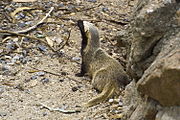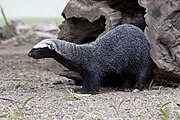Superregnum: Eukaryota
Cladus: Unikonta
Cladus: Opisthokonta
Cladus: Holozoa
Regnum: Animalia
Subregnum: Eumetazoa
Cladus: Bilateria
Cladus: Nephrozoa
Superphylum: Deuterostomia
Phylum: Chordata
Subphylum: Vertebrata
Infraphylum: Gnathostomata
Megaclassis: Osteichthyes
Cladus: Sarcopterygii
Cladus: Rhipidistia
Cladus: Tetrapodomorpha
Cladus: Eotetrapodiformes
Cladus: Elpistostegalia
Superclassis: Tetrapoda
Cladus: Reptiliomorpha
Cladus: Amniota
Cladus: Synapsida
Cladus: Eupelycosauria
Cladus: Sphenacodontia
Cladus: Sphenacodontoidea
Cladus: Therapsida
Cladus: Theriodontia
Cladus: Cynodontia
Cladus: Eucynodontia
Cladus: Probainognathia
Cladus: Prozostrodontia
Cladus: Mammaliaformes
Classis: Mammalia
Subclassis: Trechnotheria
Infraclassis: Zatheria
Supercohors: Theria
Cohors: Eutheria
Infraclassis: Placentalia
Cladus: Boreoeutheria
Superordo: Laurasiatheria
Cladus: Scrotifera
Cladus: Ferungulata
Cladus: Ferae
Cladus: Pancarnivora
Cladus: Carnivoramorpha
Cladus: Carnivoraformes
Ordo: Carnivora
Subordo: Caniformia
Infraordo: Arctoidea
Superfamilia: Musteloidea
Familia: Mustelidae
Subfamilia: Mustelinae
Genus: Galictis
Species (2): G. cuja - G. vittata
Name
Galictis Bell, 1826: 552
Type species: Viverra vittata Schreber, 1776, by original designation.
Synonyms
Galictes Bell, 1837
Gallictis Waterhouse, 1839
Grison Oken, 1816
Grisonella Thomas, 1912
Grisonia Gray, 1865
Gulo Desmarest, 1820
Huro I. Geoffroy Saint-Hilaire, 1835
Mustela Bechstein, 1800
References
Primary references
Bell, T. 1826. [Zoological Meeting, 10 January 1826, minutes of meeting]. Zoological Journal 2: 552.
Additional references
Bornholdt, R. et al. 2013: Taxonomic revision of the genus Galictis (Carnivora: Mustelidae): species delimitation, morphological diagnosis, and refined mapping of geographical distribution. Zoological journal of the Linnean Society, 167(3): 449–472. DOI: 10.1111/j.1096-3642.2012.00859.x
Links
Galictis in Mammal Species of the World.
Wilson, Don E. & Reeder, DeeAnn M. (Editors) 2005. Mammal Species of the World – A Taxonomic and Geographic Reference. Third edition. ISBN 0-8018-8221-4.
Galictis Bell, 1826 – Taxon details on Integrated Taxonomic Information System (ITIS).
Vernacular names
English: Grisóns
A grison (/ˈɡrɪzən/, /ˈɡraɪsən/) is any mustelid in the genus Galictis.[1] Native to Central and South America, the genus contains two extant species: the greater grison (Galictis vittata), which is found widely in South America, through Central America to southern Mexico; and the lesser grison (Galictis cuja), which is restricted to the southern half of South America.
Names
The generic name Galictis joins two Greek words: galē (γαλῆ, "weasel") and iktis (ἴκτις, marten/weasel).[2] Compare the word Galidictis (a mongoose genus).
The common name grison is from a French word for "gray", a variant of gris, also meaning "gray".[3]
Locally, in Spanish, it is referred to as a huroncito (literally "little ferret") or grisón. In Portuguese, it is a furão.[citation needed]
Description
Grisons measure up to 60 cm (24 in) in length,[4] and weigh between 1 and 3 kg (2.2 and 6.6 lb). The lesser grison is slightly smaller than the greater grison. Grisons generally resemble a honey badger, but with a smaller, thinner body. The pelage along the back is a frosted gray with black legs, throat, face, and belly. A sharp white stripe extends from the forehead to the back of the neck.
Habitat
They are found in a wide range of habitats from semi-open shrub and woodland to low-elevation forests. They are generally terrestrial, burrowing and nesting in holes in fallen trees or rock crevices, often living underground. They are omnivorous, consuming fruit and small animals (including mammals). Little is known about grison behavior for multiple reasons, including that their necks are so wide compared to their heads, an unusual difficulty that has made radio tracking problematic.[citation needed]
Evolution
Extant species
| Common name | Scientific name and subspecies | Range | Size and ecology | IUCN status and estimated population | |
|---|---|---|---|---|---|
| Lesser grison
|
Galictis cuja (Molina, 1782)
|
Brazil, Chile, Peru, Argentina, Uruguay, and Paraguay |
Size: Habitat: Diet: |
LC |
| Greater grison
|
Galictis vittata (Schreber, 1776)
Five subspecies
|
southern Mexico in the north, to central Brazil, Peru, and Bolivia in the south |
Size: Habitat: Diet: |
LC |
|---|
Fossils
Grisons first appeared in South America during the early Pleistocene about 2.5 million years ago. They may be descended from the fossil genera Trigonictis and Sminthosinus, which lived in North America during the mid to late Pliocene.[5] There are at least three known fossil species, all of which were found in Argentina:[4]
† Galictis hennigi
† Galictis sanandresensis
† Galictis sorgentinii
References
Wikispecies has information related to Galictis.
"ZipcodeZoo - Online Encyclopedia About Plants & Animals". Archived from the original on 21 December 2014.
"Galictis". Merriam-Webster.com Dictionary. Merriam-Webster. "New Latin, from Greek galē weasel + iktis yellow-breasted marten".
Lewis and Short defines ictis (ἴκτις) simply as "a kind of weasel".[1] Archived 2013-11-02 at the Wayback Machine Brill's New Pauly likewise also notes that "ἴκτις/íktis may be a weasel"[2]
"grison". Merriam-Webster.com Dictionary. Merriam-Webster. "French, from grison gray, from Middle French, from gris"
Yensen, E.; Tarifa, T. (2003). "Galictis vittata". Mammalian Species. 727: Number 727: pp. 1–8. doi:10.1644/727. S2CID 198121748.
Yensen, E.; Tarifa, T. (2003). "Galictis cuja". Mammalian Species. 728: Number 728: pp. 1–8. doi:10.1644/728. S2CID 198124064.
Nowak, Ronald M. (2005). Walker's Carnivores of the World. Baltimore: Johns Hopkins Press ISBN 0-8018-8032-7
Retrieved from "http://en.wikipedia.org/"
All text is available under the terms of the GNU Free Documentation License



